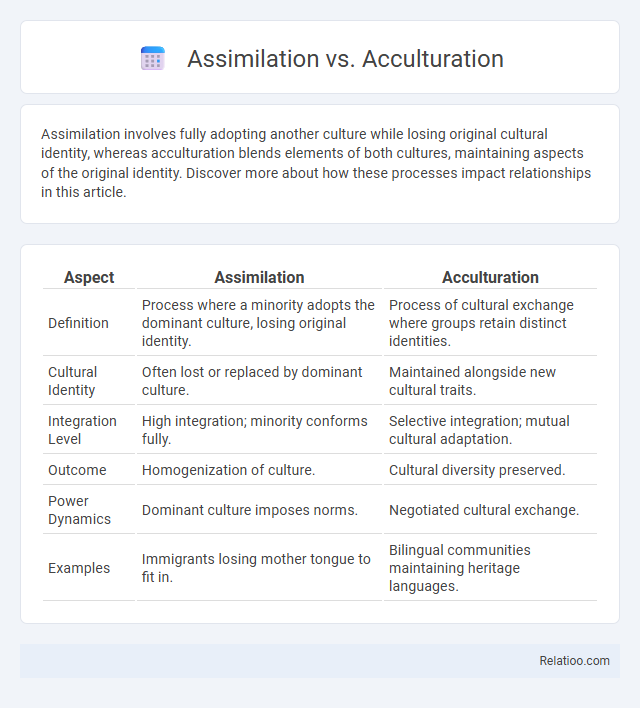Assimilation involves fully adopting another culture while losing original cultural identity, whereas acculturation blends elements of both cultures, maintaining aspects of the original identity. Discover more about how these processes impact relationships in this article.
Table of Comparison
| Aspect | Assimilation | Acculturation |
|---|---|---|
| Definition | Process where a minority adopts the dominant culture, losing original identity. | Process of cultural exchange where groups retain distinct identities. |
| Cultural Identity | Often lost or replaced by dominant culture. | Maintained alongside new cultural traits. |
| Integration Level | High integration; minority conforms fully. | Selective integration; mutual cultural adaptation. |
| Outcome | Homogenization of culture. | Cultural diversity preserved. |
| Power Dynamics | Dominant culture imposes norms. | Negotiated cultural exchange. |
| Examples | Immigrants losing mother tongue to fit in. | Bilingual communities maintaining heritage languages. |
Understanding Assimilation: Definition and Key Concepts
Assimilation involves the process by which individuals or groups adopt the cultural traits of another society, often losing distinct cultural identities in the process. Key concepts include cultural absorption, social integration, and identity transformation, emphasizing the complete merging into the dominant culture. Understanding assimilation requires recognizing the distinction between voluntary adoption and forced conformity within multicultural and sociological contexts.
What is Acculturation? An Overview
Acculturation refers to the process by which individuals or groups from one culture adopt the beliefs, practices, and social patterns of another culture, often through direct contact and interaction. Unlike assimilation, where cultural differences are minimized or lost, acculturation allows for the retention of distinct cultural identities while integrating aspects of the dominant culture. Understanding your degree of acculturation can help navigate cultural adaptation in multicultural environments effectively.
Historical Context of Assimilation and Acculturation
Assimilation in historical context refers to the process by which minority groups adopt the cultural traits of a dominant society, often losing their original identity, as seen in policies targeting Indigenous peoples in the 19th and 20th centuries. Acculturation involves a bidirectional exchange where both minority and dominant cultures influence each other while retaining distinct cultural features, exemplified in immigrant communities adapting to new societal norms without total cultural absorption. Understanding these dynamics highlights the varying outcomes of cultural interaction and the power imbalances embedded in assimilation policies versus the more reciprocal nature of acculturation.
Major Differences Between Assimilation and Acculturation
Assimilation involves fully adopting the cultural traits of a dominant group, often leading to the loss of the original cultural identity, while acculturation refers to the exchange and adaptation of cultural features between groups without complete absorption. Major differences between assimilation and acculturation include the extent of cultural change, with assimilation emphasizing unidirectional absorption and acculturation allowing for bidirectional cultural exchange. Acculturation often results in biculturalism or multicultural coexistence, whereas assimilation tends to produce cultural homogeneity.
Cultural Identity: Preservation vs Integration
Cultural identity preservation emphasizes maintaining original customs, language, and traditions within a community, often seen in assimilation where individuals fully adopt the dominant culture, leading to the gradual loss of their heritage. Acculturation involves a bidirectional exchange where individuals blend cultural traits from both their original and the dominant cultures, fostering integration without complete abandonment of identity. The balance between preservation and integration shapes the extent to which cultural identities evolve or diminish in multicultural societies.
Factors Influencing Assimilation and Acculturation
Factors influencing assimilation and acculturation include cultural similarity, social networks, and individual attitudes towards the host culture. Economic opportunities and language proficiency significantly affect the ease of integration into the dominant society. Government policies and community support systems also play crucial roles in facilitating or hindering these processes.
Benefits and Challenges of Assimilation
Assimilation involves individuals or groups fully adopting another culture, often leading to social cohesion and easier communication but risking loss of original cultural identity and heritage. Benefits of assimilation include improved economic opportunities and social integration, while challenges include feelings of alienation, identity conflict, and potential discrimination. Unlike acculturation, which allows for cultural exchange and retention of original customs, assimilation emphasizes conformity to the dominant culture, resulting in both social advantages and cultural sacrifices.
Advantages and Drawbacks of Acculturation
Acculturation offers the advantage of preserving Your cultural identity while adapting to a new society, promoting multicultural understanding and coexistence. However, it may lead to cultural conflicts and identity confusion as individuals balance differing values and traditions. The drawback includes potential psychological stress from navigating dual cultural expectations, posing challenges to mental health and social integration.
Real-World Examples: Assimilation and Acculturation in Practice
Assimilation occurs when immigrants fully adopt the host country's culture, such as the Irish in the United States during the 19th century, gradually shedding their original customs to blend seamlessly into American society. Acculturation involves a two-way exchange where both the migrant and host cultures influence each other, exemplified by Mexican Americans maintaining traditional celebrations like Dia de los Muertos while adopting English language and American customs. Your understanding of these processes highlights how cultural integration varies, affecting identity and social cohesion in diverse societies.
The Future of Cultural Adaptation in a Globalized World
Cultural adaptation in a globalized world involves dynamic processes such as assimilation, acculturation, and integration, each shaping how diverse communities blend and preserve identities. Assimilation often results in the absorption of minority cultures into a dominant one, while acculturation facilitates mutual exchange and coexistence of cultural traits without complete loss of original identities. Your future interactions will increasingly require understanding and navigating these nuanced processes to foster inclusive and adaptable multicultural environments.

Infographic: Assimilation vs Acculturation
 relatioo.com
relatioo.com